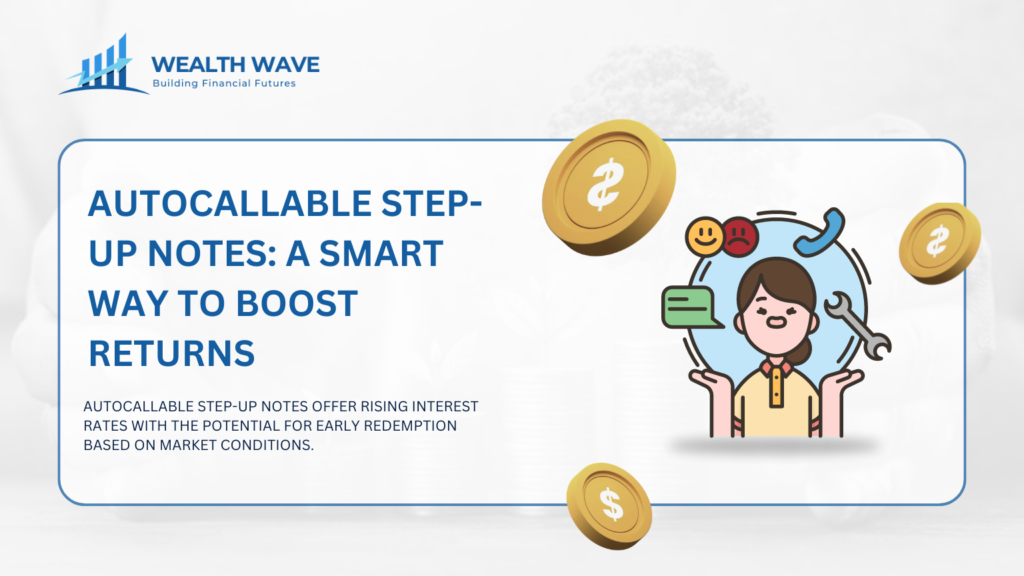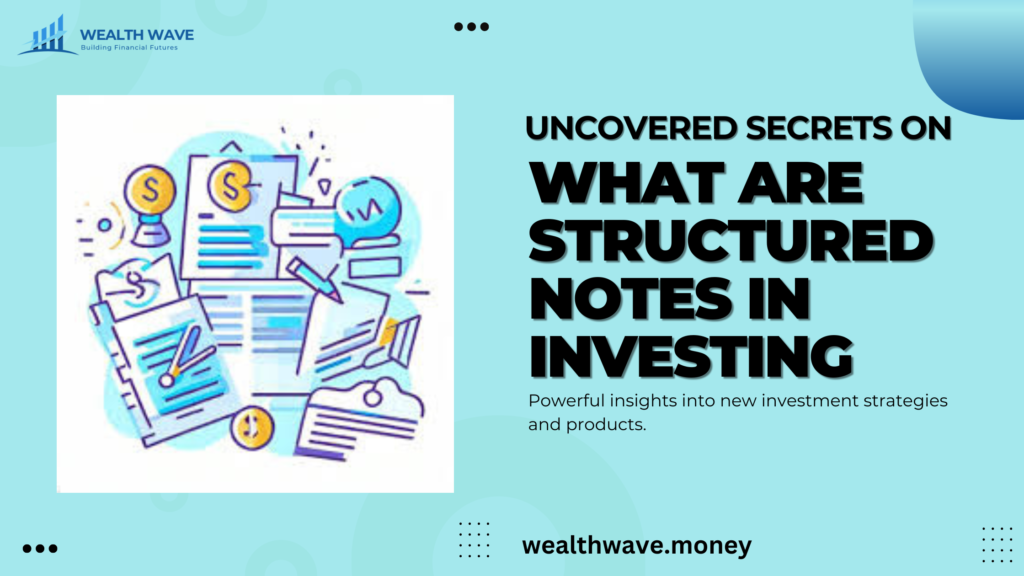
Investing can feel like wandering through a maze. We’re all yearning to get more out of our savings, but the sheer number of options can leave us scratching our heads. With interest rates languishing in the doldrums, letting your money sit in a traditional savings account feels increasingly like leaving it on the table.
That’s precisely why we’re always hunting for something more rewarding. On this quest, we stumbled upon an intriguing option that might be flying under your radar: autocallable step-up notes.
Navigating the investment landscape is daunting; I know because I’ve navigated it too, wading through endless possibilities in search of that elusive blend of decent returns and manageable risk.
It was during one such expedition that autocallable step-up notes caught my eye – investments tethered to the market performance of assets like international equity indexes and even the S&P 500® itself.
This blog is poised to walk you through everything these unique financial instruments have to offer, from their enticing potential for high returns to their inherent risks. Eager to dive deeper? Let’s keep moving forward!
Key Takeaways
- Autocallable step-up notes link payments to the performance of assets like the S&P 500®. They can automatically redeem at specific triggers, offering increasing payments over time.
- These notes carry risks, including credit risk tied to BofA Finance and BAC’s creditworthiness and liquidity risk due to potential challenges in selling them quickly.
- Investors have various options such as callable market-linked securities, growth notes, and principal-protected notes. It’s crucial to align these choices with personal investment goals while understanding individual risk tolerance.
- The maturity date and step-up payment mechanism depend on observation levels that track the performance of underlying assets. If these levels are met or exceeded, the note gets called early; otherwise, it remains until maturity with an increased call premium each year it is not called.
- Before investing in autocallable step-up notes, one must carefully evaluate their financial objectives against the backdrop of inherent risks associated with these structured investments.
What are Autocallable Step-Up Notes?

Autocallable step-up notes offer investors a unique investment opportunity. These financial instruments automatically redeem at specific triggers, while gradually increasing payments over time.
Definition and Overview

Autocallable Step-Up Notes represent structured investments that link their payments to the performance of specific underlying assets. For example, they can be tied to international equity indexes, the S&P 500®, or the Russell 2000® Value Index.
These notes have a maturity of approximately six years unless they are called before that term.
We receive automatic payments based on the notes’ performance. Each unit can be called at $10 plus the applicable Call Premium. This premium increases each year the note remains uncalled.
We must consider the credit risk associated with BofA Finance and BAC as it affects our potential returns and actual payment outcomes.
How do They Work?

Autocallable step-up notes function through a clear set of rules. They typically have a maturity period of about six years unless called earlier. Each year the note remains uncalled, the call premium increases.
This premium starts at $10 per unit. At maturity, several outcomes are possible based on the note’s performance.
Payments depend on the performance of an underlying reference, such as the S&P 500® or the Russell 2000® Value Index. We should consider the credit risk associated with BofA Finance and BAC.
Any changes in their creditworthiness can impact the payments. These structured investments require careful thought before we invest, as they may not suit every investor’s strategy.
Types of Underlying Assets (International Equity Index, S&P 500®, Russell 2000® Value Index)

Autocallable step-up notes often link their performance to various underlying assets. One common option is the international equity index. This index measures the performance of global stocks, giving us a broader market perspective.
The S&P 500® and the Russell 2000® Value Index are also popular choices. The S&P 500® tracks 500 of the largest companies in the United States. Meanwhile, the Russell 2000® Value Index focuses on smaller companies, providing a different investment angle.
Each of these assets can influence the returns we receive from our autocallable step-up notes. Understanding these underlying assets can help us make informed investment decisions.
Benefits and Risks of Autocallable Step-Up Notes

Autocallable step-up notes offer the chance for high returns in favorable market conditions. Yet, they also present risks, including credit and liquidity issues that investors must consider carefully.
Potential for High Returns
Autocallable Step-Up Notes offer a potential for high returns. These notes can mature in about six years if not called sooner. Each year that the note remains uncanceled, the call premium increases.
This structure incentivizes investors to hold onto their notes longer, which may result in larger payouts. We can receive payments based on the performance of various underlying assets, such as the S&P 500® or Russell 2000® Value Index.
As these assets perform well, we can experience significant benefits from our investments.
By investing in Autocallable Growth Notes, we align ourselves with market movements. Performance can dictate our returns, enhancing our potential earnings. Structured notes like these allow us to enjoy the benefits of market-linked investments while also having a protective mechanism against downturns.
Our opportunity for returns hinges significantly on the right underlying assets and their performance over time.
Protection Against Market Downturns
Autocallable Step-Up Notes offer a unique protection against market downturns. These notes automatically call at $10 plus the applicable Call Premium if the market performs well. This mechanism ensures we can secure our investment, even during tough market conditions.
The Call Premium increases each year the note remains uncalled. This feature allows us to potentially benefit from rising market trends while having a safeguard in place.
Structured investments like these involve various risks, but they help reduce some of the impact from market declines. Payments we receive depend on the credit risk of BofA Finance and BAC.
We must be aware of these risks. Autocallable securities give us a chance to balance potential returns with some level of protection.
Credit Risk
Credit risk poses a significant concern for Autocallable Step-Up Notes. Payments on these notes depend on the creditworthiness of BofA Finance and BAC. We face potential losses if their credit ratings decline.
This risk can affect the value of our investment. Changes in how the market perceives BofA’s stability can directly impact our returns.
Understanding this risk is crucial as we consider investing. It connects to other factors like maturity date and step-up payments.
Liquidity Risk
Liquidity risk plays a significant role in investing in Autocallable Step-Up Notes. These investments may not always be easy to sell. We face challenges when trying to convert our notes into cash quickly.
A lack of buyers can hinder our ability to liquidate these structured investments.
The secondary market for Callable Market-Linked Securities can be limited, which affects liquidity. If we want to sell our notes before maturity, we may receive less than their principal amount.
It’s essential to weigh these risks before deciding to invest in Autocallable notes.
How to Invest in Autocallable Step-Up Notes

Investing in autocallable step-up notes involves considering various options like callable market-linked securities and principal-protected notes. We should evaluate our financial goals and comfort level with the associated risks before making any decisions.
Available Options: Callable Market-linked Securities, Growth Notes, Principal-Protected Notes
We can explore several options for investing in autocallable step-up notes. Investors may choose callable market-linked securities. These securities provide the opportunity for returns tied to an underlying asset’s performance.
Growth notes are another option. They offer payments based on the success of a reference asset.
Principal-protected notes stand out by safeguarding the initial investment. These structured investments carry specific risks, so we must assess our comfort with them. It’s crucial to evaluate each option carefully and align our choices with our investment goals.
Considerations Before Investing
Before investing in Autocallable Step-Up Notes, we must weigh several factors. These structured investments involve specific risks that require careful consideration. The maturity of these notes is about six years unless called before that time.
Payments depend on the credit risk of BofA Finance and BAC. Actual or perceived changes in their creditworthiness can affect our returns.
We should also note that the automatic call occurs at $10 plus the applicable Call Premium. This premium increases each year the note remains uncalled. Investing in callable market-linked securities like these may not suit all investors.
Thus, understanding our risk tolerance is crucial.
Understanding the Maturity Date and Step-Up Payment

Understanding the maturity date and step-up payment is crucial for investors. The observation levels determine if we receive the step-up payments as scheduled.
Explanation of Observation Levels
Observation levels are crucial in understanding autocallable step-up notes. They help determine if the notes will get called early. Each observation level reflects the performance of an underlying asset.
If the asset meets or exceeds the specified level on a set date, the note gets automatically called.
We should note that the autocallable step-up notes have a maturity of around six years unless called sooner. Each unit, once called, results in a payment of $10 plus the applicable call premium.
The call premium grows each year the note remains uncanceled. This structure allows us to benefit from higher returns while keeping track of performance against these levels.
Potential Outcomes at Maturity
At maturity, Autocallable Step-Up Notes offer several outcomes based on performance and market conditions. If the notes are called, we receive $10 plus the applicable Call Premium.
This premium increases each year the note is not called, potentially boosting our returns. For instance, if the performance of the underlying assets, like the S&P 500® or the Russell 2000® Value Index, meets certain observation levels, we can benefit greatly.
If the notes are not called, the maturity approach is more complex. We will face credit risks associated with BofA Finance and BAC. Market-linked investments carry risks. The ending value at maturity will depend on the performance of the related equity-linked notes or other underlying assets.
Various potential outcomes exist, and we must carefully consider these before investing.
Conclusion

We explored autocallable step-up notes and their mechanics. These investment products can offer high returns while providing some protection against market downturns. We highlighted the risks involved, including credit and liquidity concerns.
Investing in these notes requires careful consideration of options available to us. Understanding maturity dates and step-up payments is essential for successful outcomes. By applying these insights, we can make informed decisions and potentially enhance our investment strategies.
FAQs
Q1. What are autocallable step-up notes?
Ans. Autocallable step-up notes are a type of callable market-linked securities. They're part of the derivative products family, often used in market-linked investments.
Q2. How do these step-up barrier notes work?
Ans. Step-up barrier notes function as senior unsecured debt securities. The payment steps up over time, hence the name "step-up". Barrier options play a significant role in their operation.
Q3. Are these equity-linked or principal-protected notes?
Ans. While similar to both equity-linked and principal-protected notes, autocallable step-up notes are unique due to their callable feature and stepped payments.
Q4. What is the significance of the Market Measure in relation to Autocallable Step-Up Notes?
Ans. Market Measure is critical for determining how these hybrid securities perform and when they might be called by issuers.
Q5. Can you explain more about fixed income products like autocallable step-up notes?
Ans. Sure! Fixed income products like autocallable step up-notes provide regular interest payments to investors and return the principal at maturity unless called earlier.




